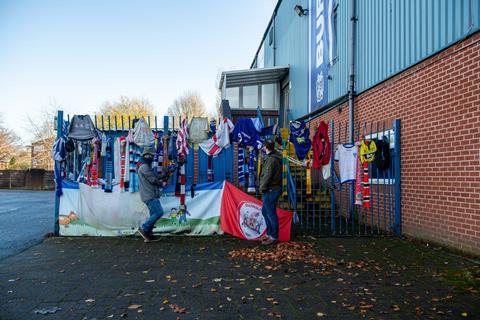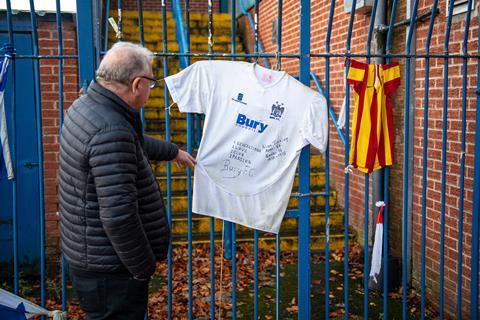Executive producer Sally Brown, director Tom Boswell, and journalist Mike Calvin told Broadcast Sport about what it took to create Ours

“The last day of filming was also the day Boris cancelled Christmas, we were driving home from Bury thinking about what we were going back into.”
BT Sport producer/director Tom Boswell, along with journalist Michael Calvin and executive producer Sally Brown, was involved in the creation of the latest BT Sport Films documentary, Ours, at the end of last year.
Ours was shot in just under eight weeks between 26 October and 19 December and was inspired by Calvin’s upcoming book Whose Game Is It Anyway. It looks at fan ownership in the modern game and how it has grown from its early days in the UK with, “the MyFootballClub experiment through to modern models such as the novelty, in a good way, of looking at Hashtag United,” Calvin explains.
Boswell, Brown, and Calvin spoke to Broadcast Sport about what it took to put the documentary together, ahead of its broadcast on BT Sport 1 this Tuesday at 10.30pm.
With the first meeting taking place on 5 October, Brown admitted: “They [Calvin and Boswell] worked out a brilliant schedule and it was quite a feat to get it made.”
However, despite the speed and pandemic-hit circumstances it was made in, Ours doesn’t want to be a ‘Covid’ documentary. This was helped by filming coming in the short period while fans were allowed back into stadiums.
Boswell explained: “We want the film to reflect the circumstances at the time but also to hold up two years down the line. A film that doesn’t look like a Covid film.”
This meant avoiding the now-ubiquitous Zoom interviews, Brown said: “It was very important that we didn’t do that. [BT Sport doc] Proud To Be Town embraced that as it was it was about the pandemic, but we didn’t want to do that with this film.”
Calvin added: “It meant, as usual with documentaries, compartmentalising the different aspects of the story. For example going from Bury to AFC Wimbledon to tell the story of phoenix clubs.
“There was definitely a natural evolution in the feel of the film as it went from place to place.
“You’re really divorced from what you perceive to be a normal football experience, but it actually still contains all those factors.
“Bury were allowed 150 fans when we were there, and what struck me was it could have been 150,000.
“You got the same characters even in a borrowed stadium with fewer fans. Two boys climbing over a wall to get in, a little girl at the hot dog stand.”
Boswell jumped in: “It was the biggest crowd we encountered. It really does feel like 150,000 after you haven’t seen a crowd for a long time.”

In fact, Boswell believes restrictions actually helped filming: “I think it makes for a more visually appealing film, it forced us to think outside the box. Those days with cold, horizontal rain added to the atmosphere and made it visually interesting. However, it was definitely a challenge for sound.”
The challenge around filming conditions was foreseen, Brown revealed: “A little bit more budget went into sound.”
Boswell added: “The cameramen, sound guys, were amazing. We had very, very good people.”
David Corfield, Damian Bradshaw and Stephen Pook were behind the cameras, with Chris Gomersall and Paul Cameron on sound. Jez Spencer then did the sound mix, with Jake Lofdahl editing and doing the colour grade. The title sequence was made by Jack Csaba Sindely.
When it came to getting this team to work together through the isolation of Covid restrictions, Brown said: “We weren’t really relying on huge innovations. Everyone could work remotely on the edit, and we benefited from everything put in during the first lockdown.
“Graphic design were phenomenal, all working remotely. It shows everything can be done remotely and that it’s all about communication.”
Boswell furthered: “Wherever possible, BT edit remotely. However, the size of a feature film meant we got to a point where you have to be in the production hub – especially with things like grading.
“Some things just can’t be done from home.”
Although, Calvin did manage his voiceover work from home: “I used Audacity from home, as I do for the Football Writers’ Podcast. It’s great to have accessibility wherever you are.”
Technical problems were few, but, as Calvin explained, some perhaps surprising ones came up: “The only technical problem I ran into was when interviewing [AFC Wimbledon director] Ivor Heller. We were doing a walk and talk interview, and it’s a natural process that you converge as you’re walking - which we had to keep an eye on given the current situation.”

Despite the successes, some changes did have to be made, Boswell explained: “We were planning to go to Germany as it’s the home of fan influenced ownership, and had extensive discussions, but we were scuppered by the travel restrictions.”
Archive footage was also vital to getting across the fan experience when crowds were limited, Boswell added: “We leant on our archive, using old crowd shots throughout. It was good to think outside the box.”
Brown continued: “We have quite a lean team, and Tom took a long time trawling through archives and contacting third parties. Great use of archive is what makes a good film great.”
The entire experience may be best summed up by a day filming at AFC Wimbledon, as Calvin revealed: “It was surreal to do the AFC Wimbledon sequence from what was essentially a building site.”
Boswell added: “Hard work sound-wise! A very chaotic day with lots of interviews. The team was training on the pitch near us and people were building right next to us. It was about embracing the chaos. We made the best of the situation.”



![Mastercard_TeamPriceless_03[43]](https://d11p0alxbet5ud.cloudfront.net/Pictures/100x67/1/6/3/1467163_mastercard_teampriceless_0343_163543.png)

No comments yet